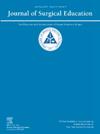Promoting Residents’ Motivation to Develop Laparoscopic Skills Through Simulation
IF 2.1
3区 医学
Q1 EDUCATION, SCIENTIFIC DISCIPLINES
引用次数: 0
Abstract
Objective
To evaluate the engagement of general surgery residents in a pilot simulation-based education curriculum promoting intrinsic motivation to develop laparoscopic technical skills.
Design
A pilot study of an 8-week simulation-based education curriculum to develop laparoscopic technical skills by fostering intrinsic motivation aligned to self-determination theory (SDT). The design followed Kern’s 6 steps to curriculum development for medical education. The curriculum addressed the basic psychological needs of autonomy, competence, and relatedness, explained in SDT, to promote intrinsic motivation. Participation, satisfaction, learning of procedural knowledge and competence were assessed using Moore’s expanded outcomes framework. Data were analyzed using quantitative and qualitative methods.
Setting
Tertiary university hospital in New Zealand. The study used the portable eoSim (Limbs & Things Ltd, Bristol, United Kingdom) laparoscopic box simulators with associated SurgTrac objective performance measurement software, exercises and biotissue models delivered at convenient locations in the hospital close to residents’ daily activities.
Participants
Department of general surgery residents were the primary target. Attendings, fellows and medical students were also able to participate in the curriculum.
Results
There were 25 participants, with 37% (15/41) of residents participating. The median number of sessions attended was 1, with a range of 1 to 9. The median time practicing on the simulator was 46 minutes, mean 119 minutes, ranging from 29 minutes to 9 hours and 38 minutes. Most junior residents and medical students reported a gain in procedural knowledge, and senior residents were able to demonstrate competence and performance. Forty percent of participants responded to the evaluation survey, and all stated that the curriculum was either useful or very useful for developing their laparoscopic technical skills.
Conclusions
A pilot simulation-based education curriculum aligned with self-determination theory (SDT) was able to intrinsically motivate a proportion of general surgery residents to develop their laparoscopic technical skills. Additional strategies to promote residents’ autonomous motivation to engage in learning and skill development are required.
通过模拟提高住院医师发展腹腔镜技术的动力
目的评估普外科住院医师在试点模拟教育课程中的参与度,以促进他们发展腹腔镜技术技能的内在动力。设计一项为期8周的模拟教育课程的试点研究,通过培养与自决理论(SDT)一致的内在动机来发展腹腔镜技术技能。设计遵循Kern的医学教育课程开发的6个步骤。课程涉及自主性、能力和相关性的基本心理需求,在SDT中解释,以促进内在动机。参与性、满意度、程序性知识的学习和能力采用摩尔扩展结果框架进行评估。采用定量和定性相结合的方法对资料进行分析。新西兰第三大学医院。本研究使用便携式eoSim (Limbs &;Things Ltd, Bristol, United Kingdom)的腹腔镜盒模拟器,配备相关的SurgTrac客观性能测量软件、练习和生物组织模型,可在医院靠近居民日常活动的方便位置交付。研究对象:普通外科住院医师为主要研究对象。主治医师、研究员和医科学生也能够参加课程。结果共纳入25人,居民参与率为37%(15/41)。参加会议的中位数为1次,范围为1到9次。在模拟器上练习的时间中位数为46分钟,平均119分钟,范围从29分钟到9小时38分钟。大多数初级住院医生和医学生报告说,他们在程序知识方面有所收获,而老年住院医生能够展示自己的能力和表现。40%的参与者对评估调查做出了回应,所有人都表示课程对发展他们的腹腔镜技术技能有用或非常有用。结论与自我决定理论(SDT)相结合的试点模拟教育课程能够从本质上激励一部分普外科住院医师发展他们的腹腔镜技术技能。需要采取其他策略来促进居民自主学习和技能发展的动机。
本文章由计算机程序翻译,如有差异,请以英文原文为准。
求助全文
约1分钟内获得全文
求助全文
来源期刊

Journal of Surgical Education
EDUCATION, SCIENTIFIC DISCIPLINES-SURGERY
CiteScore
5.60
自引率
10.30%
发文量
261
审稿时长
48 days
期刊介绍:
The Journal of Surgical Education (JSE) is dedicated to advancing the field of surgical education through original research. The journal publishes research articles in all surgical disciplines on topics relative to the education of surgical students, residents, and fellows, as well as practicing surgeons. Our readers look to JSE for timely, innovative research findings from the international surgical education community. As the official journal of the Association of Program Directors in Surgery (APDS), JSE publishes the proceedings of the annual APDS meeting held during Surgery Education Week.
 求助内容:
求助内容: 应助结果提醒方式:
应助结果提醒方式:


